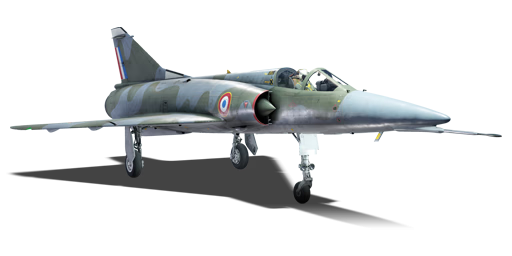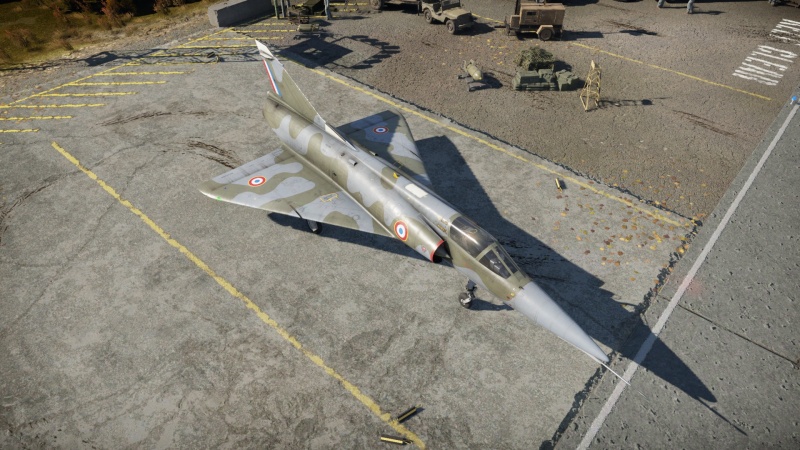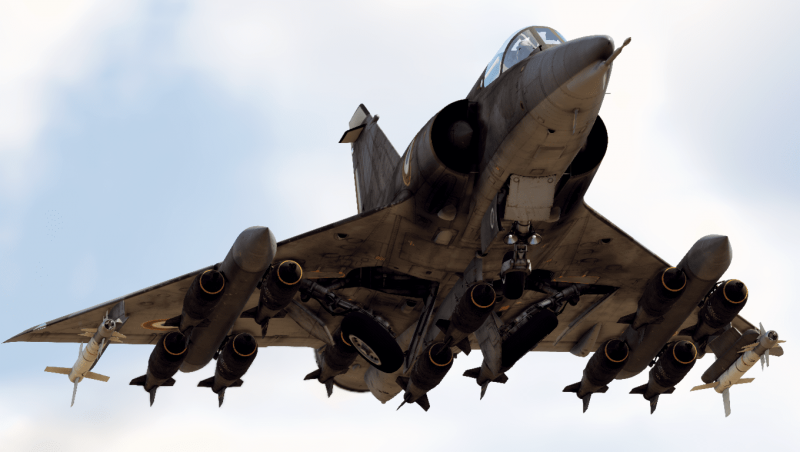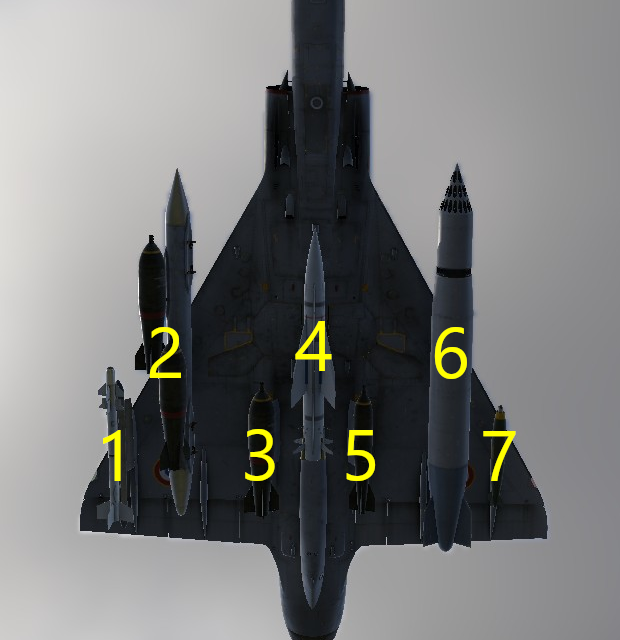Difference between revisions of "Mirage 5F"
(→Description: fixed wording in description per Inceptor57's request) (Tag: Visual edit) |
Colok76286 (talk | contribs) (Edits) |
||
| Line 11: | Line 11: | ||
== Description == | == Description == | ||
<!-- ''In the description, the first part should be about the history of and the creation and combat usage of the aircraft, as well as its key features. In the second part, tell the reader about the aircraft in the game. Insert a screenshot of the vehicle, so that if the novice player does not remember the vehicle by name, he will immediately understand what kind of vehicle the article is talking about.'' --> | <!-- ''In the description, the first part should be about the history of and the creation and combat usage of the aircraft, as well as its key features. In the second part, tell the reader about the aircraft in the game. Insert a screenshot of the vehicle, so that if the novice player does not remember the vehicle by name, he will immediately understand what kind of vehicle the article is talking about.'' --> | ||
| − | The Mirage III was a true workhorse of the Israeli Air Force with considerably successful combat records, however, it still left much to be desired by the IAF. As a result, the IAF reached out to Dassault to request a new "refined" version of the Mirage III specifically for Middle Eastern combat, with the result of this program called the "Mirage 5". The Israelis suggested that radar and most of the related sensors and avionics from the standard Mirage IIIE should be removed to reduce cost, weight, and maintenance; and replacing them with more fuel storage for prolonged attack missions, since the radar and related sensors were deemed "unnecessary" in the clear and sunny skies of the Middle East. In September 1966, the Israelis placed an order for 50 of the new Mirage 5, but due to French President De Gaulle's arms embargo against | + | The Mirage III was a true workhorse of the Israeli Air Force with considerably successful combat records, however, it still left much to be desired by the IAF. As a result, the IAF reached out to Dassault to request a new "refined" version of the Mirage III specifically for Middle Eastern combat, with the result of this program called the "Mirage 5". The Israelis suggested that radar and most of the related sensors and avionics from the standard Mirage IIIE should be removed to reduce cost, weight, and maintenance; and replacing them with more fuel storage for prolonged attack missions, since the radar and related sensors were deemed "unnecessary" in the clear and sunny skies of the Middle East. In September 1966, the Israelis placed an order for 50 of the new Mirage 5, but due to French President De Gaulle's arms embargo against Israel shortly after in 1967, none of the Mirage 5s were delivered to Israel. In late 1969, the Israelis, who had pilots in France testing the aircraft, requested that the aircraft be transferred to Corsica, in theory to allow them to continue flight training in warm conditions during the French winter. The French government rejected the request when the Israelis also tried to obtain long-range fuel tanks, which seemed highly suspicious to the French officials as Corsica was not far enough from the French mainland to warrant long-range fuel tanks. The Israelis finally gave up trying to acquire the aircraft after that and accepted a refund, but unbeknownst to the French, the Israelis had only accepted the refund because their espionage assets had successfully stolen the Mirage 5's blueprints from Dassault, resulting in the indigenously built [[Nesher]] copy instead. |
| − | Introduced in [[Update "Winged Lions"]], the Mirage 5F is completely identical to the [[Nesher]], minus its air-to-air missile loadout, with the French version equipping AIM-9Bs and the indigenous [[Matra R550 Magic 1|R.550 Magic 1]] missile instead of the Israeli [[Shafrir 2]] missile. The aircraft lacks radar and can only equip two on-par close range air-to-air missiles. The Mirage 5 is best equipped for frontline bomber roles, however it still struggles in this role due to the lack of countermeasures. The Mirage is best played defensively at all times, maintaining a distance from enemies (especially those with all aspect missiles) to bomb bases and pounce on unsuspecting targets using its great speed and short- | + | Introduced in [[Update "Winged Lions"]], the Mirage 5F is completely identical to the [[Nesher]], minus its air-to-air missile loadout, with the French version equipping AIM-9Bs and the indigenous [[Matra R550 Magic 1|R.550 Magic 1]] missile instead of the Israeli [[Shafrir 2]] missile. The aircraft lacks radar and can only equip two on-par close range air-to-air missiles. The Mirage 5 is best equipped for frontline bomber roles, however it still struggles in this role due to the lack of countermeasures. The Mirage is best played defensively at all times, maintaining a distance from enemies (especially those with all aspect missiles) to bomb bases and pounce on unsuspecting targets using its great speed and short-term dogfight performance. |
== General info == | == General info == | ||
Revision as of 03:06, 31 January 2024
| This page is about the French jet fighter Mirage 5F. For other versions, see Mirage 5 (Family). |
Contents
Description
The Mirage III was a true workhorse of the Israeli Air Force with considerably successful combat records, however, it still left much to be desired by the IAF. As a result, the IAF reached out to Dassault to request a new "refined" version of the Mirage III specifically for Middle Eastern combat, with the result of this program called the "Mirage 5". The Israelis suggested that radar and most of the related sensors and avionics from the standard Mirage IIIE should be removed to reduce cost, weight, and maintenance; and replacing them with more fuel storage for prolonged attack missions, since the radar and related sensors were deemed "unnecessary" in the clear and sunny skies of the Middle East. In September 1966, the Israelis placed an order for 50 of the new Mirage 5, but due to French President De Gaulle's arms embargo against Israel shortly after in 1967, none of the Mirage 5s were delivered to Israel. In late 1969, the Israelis, who had pilots in France testing the aircraft, requested that the aircraft be transferred to Corsica, in theory to allow them to continue flight training in warm conditions during the French winter. The French government rejected the request when the Israelis also tried to obtain long-range fuel tanks, which seemed highly suspicious to the French officials as Corsica was not far enough from the French mainland to warrant long-range fuel tanks. The Israelis finally gave up trying to acquire the aircraft after that and accepted a refund, but unbeknownst to the French, the Israelis had only accepted the refund because their espionage assets had successfully stolen the Mirage 5's blueprints from Dassault, resulting in the indigenously built Nesher copy instead.
Introduced in Update "Winged Lions", the Mirage 5F is completely identical to the Nesher, minus its air-to-air missile loadout, with the French version equipping AIM-9Bs and the indigenous R.550 Magic 1 missile instead of the Israeli Shafrir 2 missile. The aircraft lacks radar and can only equip two on-par close range air-to-air missiles. The Mirage 5 is best equipped for frontline bomber roles, however it still struggles in this role due to the lack of countermeasures. The Mirage is best played defensively at all times, maintaining a distance from enemies (especially those with all aspect missiles) to bomb bases and pounce on unsuspecting targets using its great speed and short-term dogfight performance.
General info
Flight performance
| Characteristics | Max Speed (km/h at 12,000 m) |
Max altitude (metres) |
Turn time (seconds) |
Rate of climb (metres/second) |
Take-off run (metres) | |||
|---|---|---|---|---|---|---|---|---|
| AB | RB | AB | RB | AB | RB | |||
| Stock | 2,090 | 2,053 | 16000 | 29.9 | 30.6 | 109.7 | 99.7 | 750 |
| Upgraded | 2,233 | 2,160 | 26.3 | 28.0 | 172.5 | 140.0 | ||
Details
| Features | |||||
|---|---|---|---|---|---|
| Combat flaps | Take-off flaps | Landing flaps | Air brakes | Arrestor gear | Drogue chute |
| X | X | X | ✓ | X | ✓ |
| Limits | ||||||
|---|---|---|---|---|---|---|
| Wings (km/h) | Gear (km/h) | Flaps (km/h) | Max Static G | |||
| Combat | Take-off | Landing | + | - | ||
| 1,460 | 426 | N/A | N/A | N/A | ~10 | ~4 |
| Optimal velocities (km/h) | |||
|---|---|---|---|
| Ailerons | Rudder | Elevators | Radiator |
| < 920 | < 750 | < 650 | N/A |
Engine performance
| Engine | Aircraft mass | ||||||
|---|---|---|---|---|---|---|---|
| Engine name | Number | Basic mass | Wing loading (full fuel) | ||||
| SNECMA Atar 9C | 1 | 7,250 kg | 300 kg/m2 | ||||
| Engine characteristics | Mass with fuel (no weapons load) | Max Takeoff Weight | |||||
| Weight (each) | Type | 10m fuel | 20m fuel | 30m fuel | 34m fuel | ||
| 1,450 kg | Afterburning axial-flow turbojet | 7,934 kg | 8,577 kg | 9,241 kg | 9,531 kg | _,___ kg | |
| Maximum engine thrust @ 0 m (RB/SB) | Thrust to weight ratio @ 0 m (WEP) | ||||||
| Condition | 100% | WEP | 10m fuel | 20m fuel | 30m fuel | 34m fuel | MTOW |
| Stationary | 4,210 kgf | 6,110 kgf | 0.77 | 0.71 | 0.66 | 0.64 | _.__ |
| Optimal | 5,389 kgf (1,200 km/h) |
8,594 kgf (1,200 km/h) |
1.08 | 1.00 | 0.93 | 0.90 | _.__ |
Survivability and armour
The Mirage 5F has no armour and can be critically damaged with just one short burst of enemy fire. Even if the Mirage survives, it will be highly damaged and some major components like the elevator or aileron controls will likely be destroyed. The Mirage has self-sealing fuel tanks located in the rear, front part of the wings, and the forward fuselage.
Modifications and economy
Armaments
| Ballistic Computer | |||
|---|---|---|---|
| CCIP (Guns) | CCIP (Rockets) | CCIP (Bombs) | CCRP (Bombs) |
| |
|
|
|
Offensive armament
The Mirage 5F is armed with:
- 2 x 30 mm DEFA 552A cannons, belly-mounted (140 rpg = 280 total)
Suspended armament
The Mirage 5F can be outfitted with the following ordnance:
| 1 | 2 | 3 | 4 | 5 | 6 | 7 | ||
|---|---|---|---|---|---|---|---|---|
| 250 lb SAMP Mk 81 bombs | 1 | 1 | ||||||
| 250 kg SAMP Type 25 bombs | 4 | 1 | 2 | 1 | 4 | |||
| 250 kg SAMP Type 25 200 bombs | 1 | 2 | 1 | |||||
| 400 kg SAMP Type 21 bombs | 2 | 1 | 2 | 1 | 2 | |||
| 400 kg SAMP Type 21 200 bombs | 1 | 2 | 1 | |||||
| FZ49 rockets | 7 | 7 | ||||||
| SNEB type 23 rockets | 18, 36 | 18, 36 | ||||||
| AIM-9B Sidewinder missiles | 1 | 1 | ||||||
| AS-30 Nord missiles | 1 | |||||||
| Matra R550 Magic 1 missiles | 1 | 1 | ||||||
| Maximum permissible weight imbalance: 1,500 kg | ||||||||
| Default weapon presets | |
|---|---|
| |
Usage in battles
Comparable to the Mirage IIIC in performance, the 5F lacks some of the electronics and missiles that make contemporary jets very competitive in aggressive fights.
Because of that, and its lack of countermeasures, the Mirage 5F's most important asset is retaining its speed. Since is a very fast aircraft, it is better used in a support role or doing passes around the map at high speeds, launching the missiles at priority targets that might be a threat to the Mirage or to save an ally from death. This good use of its ammunition is extremely important since the Mirage can only carry a maximum of 2 AAMs, one on each wing. Be careful, though, as the 2 Magic 1's are very short in range, take a second to arm, and suffer from a lot of drag. Its guns, while great and easy to aim, have a low muzzle velocity and work better at low speeds when it is easier to point the nose of the aircraft in the desired direction. But since they are 30 mm cannons, they will destroy any aircraft with a small burst, making them very reliable.
Going for ground bases is a good option in the Mirage 5F. The Mirage 5F is capable of carrying enough bombs to destroy a full base and still carry 2 missiles for air-to-air combat. When doing this, flying at medium altitudes and then diving to the bases is very important to stay alive, because when flying to close to the ground the enemy SPAA around the map can easily destroy or severely damage your aircraft. At the moment of approaching the base, it is important to go in a dive or lower your altitude closer to the ground because the Mirage has no ballistic computer at all. Once the bombs are dropped, the Mirage may be capable of playing aggressive in the middle of the match, since at that point most fights would have already started and enemies would be distracted. Thus climbing to high altitudes or playing too cautiously may result in a defeat, since your allies would need you helping in the fight.
The 5F's energy retention is decent at best, so be careful when dogfighting and choose your opponents wisely.
Pros and cons
Pros:
- Good missiles; IR-guided Magics are very agile and have high G limits
- Hard hitting guns
- Decent loadout options
- Nimble attacker
Cons:
- Only two missiles
- Doesn't have access to laser-guided ordnance
- No flares or chaff of any kind
- Frequent uptiers against more capable jets
History
Describe the history of the creation and combat usage of the aircraft in more detail than in the introduction. If the historical reference turns out to be too long, take it to a separate article, taking a link to the article about the vehicle and adding a block "/History" (example: https://wiki.warthunder.com/(Vehicle-name)/History) and add a link to it here using the main template. Be sure to reference text and sources by using <ref></ref>, as well as adding them at the end of the article with <references />. This section may also include the vehicle's dev blog entry (if applicable) and the in-game encyclopedia description (under === In-game description ===, also if applicable).
Media
- Skins
See also
Links to the articles on the War Thunder Wiki that you think will be useful for the reader, for example:
External links
Paste links to sources and external resources, such as:
- topic on the official game forum;
- other literature.
| Dassault Aviation | |
|---|---|
| WW2* | |
| Fighters | M.B.152C1 · M.B.157 |
| Bombers | M.B.162 · M.B.174A-3 · M.B.175T |
| Jet Aircraft | |
| M.D 450 | M.D.450B Barougan · M.D.450B Ouragan |
| Mystère | M.D.452 IIA · M.D.452 IIC · Mystere IVA |
| Super Mystère | Super Mystere B2 |
| Étendard | Etendard IVM |
| Super Étendard | Super Etendard |
| Alpha Jet | Alpha Jet E** |
| Mirage | |
| Mirage III | Mirage IIIC · Mirage IIIE · Milan |
| Mirage V | Mirage 5F |
| Mirage F1 | Mirage F1C · Mirage F1C-200 · Mirage F1CT |
| Mirage 2000 | Mirage 2000-5F · Mirage 2000C-S4 · Mirage 2000C-S5 · Mirage 2000D-R1 · Mirage 2000D-RMV |
| Mirage 4000 | Mirage 4000 |
| Export | |
| M.D 450 | M.D.450B Ouragan |
| Mystere | Mystere IVA |
| Super Mystère | Sambad · Sa'ar*** |
| Mirage | Shahak · ▄Mirage 5BA · ␗Mirage 2000-5Ei |
| *The company was named "Société des Avions Marcel Bloch" before being renamed in 1947 | |
| **Jointly manufactured with Dornier Flugzeugwerke | |
| ***Israeli Super Mystère refitted with new avionics and an American engine | |
| See also | SABCA |
| France jet aircraft | |
|---|---|
| Fighters | M.D.450B Ouragan · M.D.450B Barougan · M.D.452 IIA · M.D.452 IIC · Mystere IVA · Super Mystere B2 |
| ▄F-86K · ▄F-100D · ▄F-8E(FN) | |
| Mirage IIIC · Mirage IIIE · Milan · Mirage 5F · Mirage 2000C-S4 · Mirage 2000C-S5 · Mirage 2000-5F · Mirage 4000 | |
| Mirage F1C · Mirage F1C-200 · Mirage F1CT | |
| Strike aircraft | ▄F-84F · F-84F IAF · ▄F-84G-26-RE |
| Etendard IVM · Super Etendard · Alpha Jet E | |
| Jaguar A · Jaguar E · Mirage 2000D-R1 · Mirage 2000D-RMV | |
| Bombers | S.O.4050 Vautour IIA · Vautour IIA IDF/AF · S.O.4050 Vautour IIB · S.O.4050 Vautour IIN · S.O.4050 Vautour IIN (late) |
| Belgium | ▄Meteor F Mk.8 · ▄Mirage 5BA · ▄F-104G · ▄F-16A · ▄F-16AM |
| Netherlands | ◘Sea Hawk Mk.50 · ◘Hunter F.6 |







